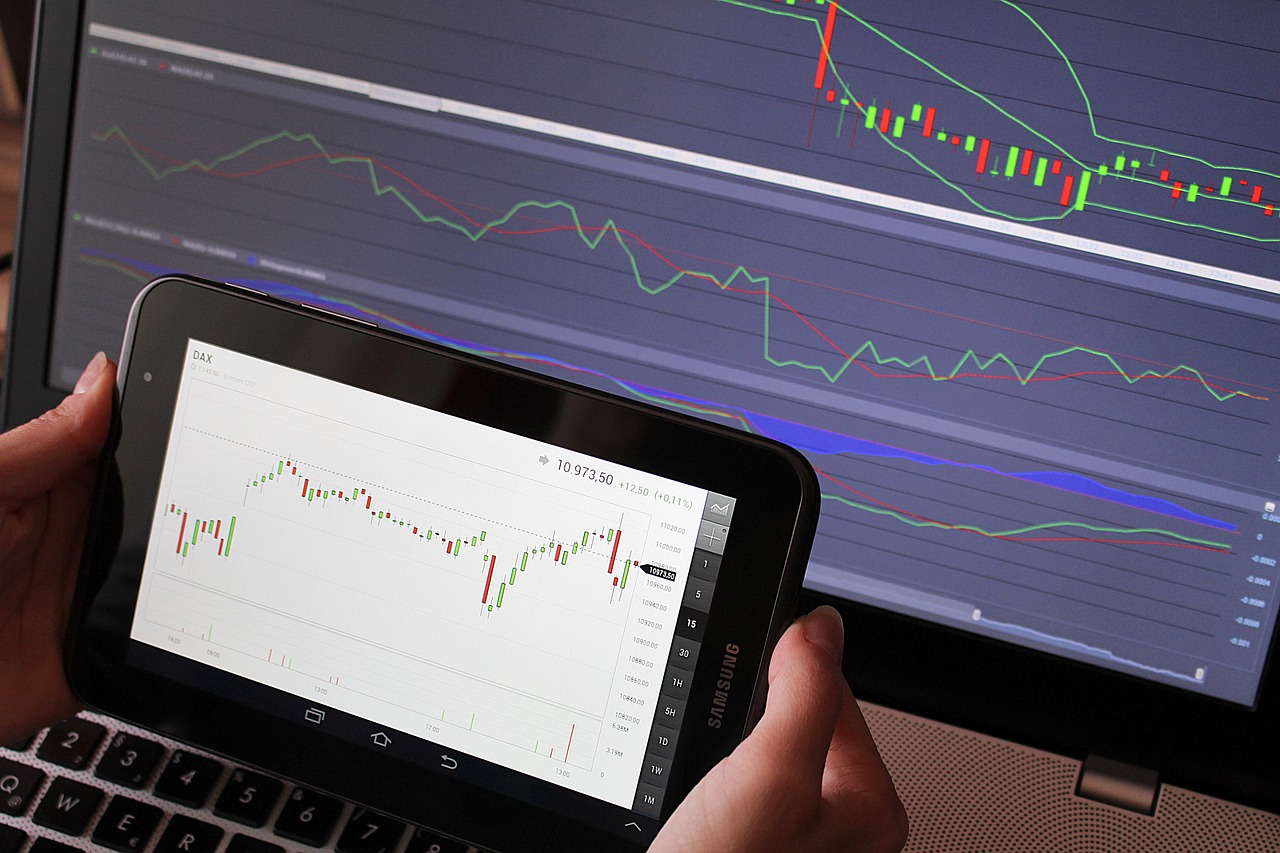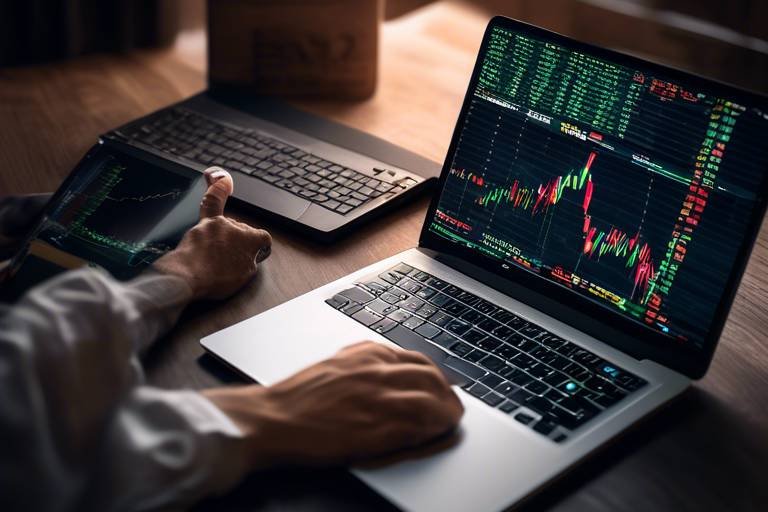The Role of Timing in Cryptocurrency Trading
Timing is everything in the world of cryptocurrency trading. Just like a seasoned chef knows exactly when to flip a pancake, successful traders understand the importance of entering and exiting positions at the right moments. The cryptocurrency market is notorious for its volatility, with prices that can swing wildly in a matter of minutes. This unpredictability makes it crucial for traders to develop a keen sense of timing to maximize profits and minimize losses.
Imagine standing at a bus stop, waiting for the right bus to take you to your destination. If you arrive too early, you waste time; arrive too late, and you miss your ride. The same principle applies to trading cryptocurrencies. Without a solid grasp of timing, you could find yourself buying high and selling low, which is a surefire way to drain your trading account. By understanding market cycles, utilizing technical analysis tools, and staying informed about news and events, traders can significantly improve their timing and overall trading success.
In this article, we will delve into the critical aspects of timing in cryptocurrency trading, exploring various strategies and psychological factors that influence traders' decisions. We will also discuss how to leverage market trends and technical indicators to identify optimal entry and exit points. So, buckle up, and let's explore the fascinating world of cryptocurrency trading timing!
Market cycles are like the seasons of nature; they have their ups and downs, and understanding them can make all the difference in your trading journey. Cryptocurrency prices don’t just fluctuate randomly; they follow patterns that can be identified and analyzed. Recognizing these cycles helps traders make informed decisions, enhancing their potential for profit and reducing risks associated with volatile markets.
There are generally four phases in a market cycle: accumulation, uptrend, distribution, and downtrend. Each phase has its own characteristics and requires different strategies. For instance:
- Accumulation: This phase occurs after a downtrend when prices stabilize, and savvy traders begin to buy.
- Uptrend: Prices start to rise as more buyers enter the market, often leading to a bullish sentiment.
- Distribution: After reaching new highs, traders start to sell off their assets, leading to increased volatility.
- Downtrend: This phase is characterized by falling prices, where panic selling can occur.
By understanding these cycles, traders can position themselves strategically to capitalize on price movements and avoid potential pitfalls.
Technical analysis tools are essential for predicting price movements in the cryptocurrency market. These tools help traders analyze past market data to forecast future trends, making them invaluable for timing trades effectively. Popular indicators and chart patterns can signal optimal entry and exit points, helping traders make informed decisions.
One of the most commonly used tools in technical analysis is the moving average. Moving averages smooth out price data, providing insights into trends and helping traders identify potential reversal points. There are different types of moving averages, each serving a unique purpose in timing trades effectively.
The Simple Moving Average (SMA) is calculated by averaging a set number of past prices. For example, a 50-day SMA takes the average of the last 50 days' closing prices. This indicator is straightforward and helps traders identify the overall trend direction. When the price crosses above the SMA, it can signal a buying opportunity, while a cross below may indicate a selling point.
On the other hand, the Exponential Moving Average (EMA) gives more weight to recent prices, making it more responsive to new information. In fast-moving markets like cryptocurrency, the EMA can provide traders with timely signals to enter or exit trades. By utilizing both the SMA and EMA, traders can create a robust strategy that accounts for both long-term trends and short-term price movements.
Support and resistance levels are crucial for timing trades effectively. These levels act as psychological barriers where the price tends to bounce back or reverse direction. Identifying these levels can help traders make educated decisions about when to enter or exit positions. For instance, if a cryptocurrency consistently bounces off a support level, it might indicate a good buying opportunity. Conversely, if it struggles to break through a resistance level, it could signal a potential sell point.
In the world of cryptocurrency, news and events can drastically affect prices. Traders must stay informed and adjust their strategies based on real-time information and market sentiment. Whether it’s a major technological breakthrough, regulatory changes, or macroeconomic trends, being aware of these factors can significantly influence trading decisions.
Economic indicators, such as inflation rates, employment data, and consumer confidence, can influence market trends. Traders should monitor these indicators closely to anticipate market movements and make timely trading decisions. For instance, a positive jobs report might boost investor confidence, leading to a surge in cryptocurrency prices.
Regulatory changes can create volatility in the cryptocurrency market. New laws or regulations can have a profound impact on how cryptocurrencies are traded and perceived. Traders must be prepared for such changes and react quickly to optimize their trading strategies. Staying informed about regulatory developments can help traders navigate the often turbulent waters of the cryptocurrency market.
What is the best time to trade cryptocurrencies? The best time to trade often depends on market trends and personal schedules. Many traders find that trading during peak hours when the market is most active can lead to better opportunities.
How do I know when to buy or sell? Utilizing technical analysis tools, such as moving averages and support/resistance levels, can help determine optimal buy and sell points based on market conditions.
Can news affect cryptocurrency prices? Absolutely! News and events can cause significant price fluctuations, making it essential for traders to stay updated on current events.

Understanding Market Cycles
The world of cryptocurrency is akin to a roller coaster ride, filled with exhilarating highs and gut-wrenching lows. Understanding market cycles is essential for any trader looking to navigate this thrilling landscape effectively. Market cycles refer to the recurring patterns of price movements that cryptocurrencies experience over time. These cycles can be influenced by a myriad of factors, including market sentiment, economic conditions, and even regulatory changes. By recognizing these cycles, traders can make informed decisions, enhancing their potential for profit while minimizing risks associated with the volatile nature of cryptocurrencies.
At the core of market cycles are the phases of accumulation, uptrend, distribution, and downtrend. Each phase offers unique opportunities and challenges:
- Accumulation: This is the phase where savvy traders start buying assets at lower prices, often following a prolonged downtrend. It’s the calm before the storm, where the groundwork for future price increases is laid.
- Uptrend: After accumulation, the market enters an uptrend phase, characterized by increasing prices and growing investor interest. This is where traders can capitalize on rising values, but caution is necessary as the trend can reverse at any moment.
- Distribution: As prices peak, the market shifts into the distribution phase. Here, traders who bought during the accumulation phase begin to sell off their assets, leading to a potential price correction. This phase is often marked by increased volatility.
- Downtrend: Following distribution, the market typically enters a downtrend, where prices decline. This phase can be disheartening, but it also presents opportunities for astute traders to buy low and prepare for the next cycle.
Understanding these phases is crucial for timing your trades. For instance, if you're aware that the market is in an accumulation phase, it might be wise to consider entering the market. Conversely, if the market is in a distribution phase, it may be time to take profits and exit. The key is to stay vigilant and be attuned to market signals that indicate which phase the market is currently in.
Moreover, market cycles are not just about price movements; they also reflect the psychological factors at play among traders. Emotions such as fear and greed can significantly impact decision-making. During the uptrend, excitement can lead to irrational buying, while fear can cause panic selling in a downtrend. Recognizing these emotional triggers can provide traders with a competitive edge, allowing them to act rationally rather than reactively.
In conclusion, understanding market cycles is not merely about analyzing charts; it's about grasping the underlying human emotions and market dynamics that drive price movements. By mastering the art of timing within these cycles, traders can position themselves for optimal results in the ever-evolving cryptocurrency landscape.

Technical Analysis Tools
When it comes to cryptocurrency trading, having the right tools at your disposal can make all the difference. Technical analysis is a method used by traders to evaluate and predict future price movements based on historical data. By analyzing price charts and patterns, traders can identify potential entry and exit points, enhancing their chances of making profitable trades. But what are the essential tools that every trader should be familiar with? Let's dive into some of the most popular technical analysis tools that can help you time your trades more effectively.
One of the most widely used tools in technical analysis is the moving average. This tool helps smooth out price data over a specific period, allowing traders to identify the direction of the trend more clearly. There are different types of moving averages, but two of the most common are the Simple Moving Average (SMA) and the Exponential Moving Average (EMA). Each has its own unique characteristics and can be utilized in various trading strategies.
The Simple Moving Average (SMA) is calculated by taking the average of a set number of prices over a defined period. For example, a 10-day SMA would average the closing prices of the last ten days. This helps traders understand the overall direction of the market. The significance of the SMA lies in its ability to filter out the noise of short-term price fluctuations, giving traders a clearer picture of the long-term trend. However, it's important to note that while the SMA is a great tool for identifying trends, it may lag behind current market conditions, which can sometimes lead to missed opportunities.
On the other hand, the Exponential Moving Average (EMA) gives more weight to recent prices, making it more sensitive to new information. This characteristic makes the EMA particularly useful in fast-moving markets like cryptocurrency. Traders often use the EMA to spot potential reversals and to determine the best time to enter or exit a trade. The EMA can be calculated using a formula that takes into account the previous EMA and the current price, making it a dynamic tool that adapts to market changes.
Another crucial aspect of timing trades is understanding support and resistance levels. These levels act as psychological barriers where the price tends to bounce back or break through. Support levels are price points where buying interest is strong enough to overcome selling pressure, while resistance levels are where selling interest prevails over buying. Identifying these levels can help traders make informed decisions about when to enter or exit a trade. By observing historical price action, traders can draw horizontal lines on their charts to mark these levels. When the price approaches these lines, traders can prepare for potential reversals or breakouts.
In summary, technical analysis tools like moving averages and support and resistance levels play a vital role in timing trades in the cryptocurrency market. By utilizing these tools, traders can enhance their decision-making process, ultimately leading to improved trading outcomes.
- What is the best time frame for using moving averages?
It depends on your trading style. Day traders may prefer shorter time frames like 5-minute or 15-minute charts, while swing traders might use daily or weekly charts. - Can I use technical analysis for all cryptocurrencies?
Yes, technical analysis can be applied to any cryptocurrency, but the effectiveness may vary based on market conditions and the specific coin's volatility. - How often should I update my technical analysis?
It's advisable to update your analysis regularly, especially in the fast-paced world of cryptocurrency. Staying informed about market trends can help you make timely decisions.

Moving Averages
When it comes to cryptocurrency trading, timing is everything. One of the most powerful tools at a trader's disposal is the moving average. This tool helps smooth out price fluctuations, allowing traders to focus on the underlying trends rather than getting bogged down by short-term volatility. By averaging price data over a specific period, moving averages can reveal important insights into market momentum and potential reversals.
There are several types of moving averages, each serving its unique purpose. The two most commonly used are the Simple Moving Average (SMA) and the Exponential Moving Average (EMA). Understanding the distinctions between these averages is crucial for effectively timing your trades. While the SMA gives equal weight to all prices in the period, the EMA places greater emphasis on the most recent prices, making it more responsive to new information.
Let's break down how these moving averages can be utilized:
- Simple Moving Average (SMA): This average is calculated by adding the closing prices over a specific number of periods and then dividing by that number. For instance, a 10-day SMA would average the closing prices of the last 10 days. Traders often use the SMA to identify long-term trends.
- Exponential Moving Average (EMA): The EMA is calculated in a way that gives more weight to recent prices, making it more sensitive to price changes. This characteristic allows traders to react more swiftly to market movements, which can be particularly beneficial in the fast-paced world of cryptocurrency.
In the context of trading, moving averages can be employed in various strategies. For example, traders might look for crossover points, where a short-term moving average crosses above or below a long-term moving average. This crossover can signal potential buy or sell opportunities. Additionally, moving averages can also serve as dynamic support and resistance levels, helping traders identify where prices may bounce or reverse.
To illustrate the effectiveness of moving averages, consider the following table that outlines the key differences between SMA and EMA:
| Feature | Simple Moving Average (SMA) | Exponential Moving Average (EMA) |
|---|---|---|
| Calculation Method | Equal weight to all prices in the period | More weight to recent prices |
| Responsiveness | Slower to react to price changes | Faster to react to price changes |
| Best Used For | Identifying long-term trends | Short-term trading and quick reactions |
In summary, moving averages are invaluable for traders looking to optimize their timing in the cryptocurrency market. By understanding how to apply both the SMA and EMA, traders can enhance their decision-making process and potentially increase their profitability. As you dive deeper into the world of moving averages, remember that practice makes perfect. The more you familiarize yourself with these tools, the better equipped you'll be to navigate the volatile waters of cryptocurrency trading.
Q: What is the main purpose of using moving averages in trading?
A: Moving averages help traders identify trends and potential reversal points by smoothing out price data over a specified period.
Q: How do I choose the right period for a moving average?
A: The choice of period depends on your trading strategy. Shorter periods (like 10 or 20 days) are more responsive and suitable for day trading, while longer periods (like 50 or 200 days) are better for identifying long-term trends.
Q: Can moving averages predict future prices?
A: While moving averages can indicate trends and potential price movements, they should not be solely relied upon for predictions. They are best used in conjunction with other technical analysis tools.

Simple Moving Average (SMA)
The is one of the most fundamental tools in the trader's toolkit, acting as a reliable indicator for analyzing price trends over a specified period. By calculating the average price of a cryptocurrency over a set number of days, the SMA helps traders smooth out price fluctuations and identify potential market trends. For instance, if a trader is analyzing the price of Bitcoin over the last 20 days, the SMA will sum up the closing prices of Bitcoin for those days and then divide by 20, providing a clearer picture of the asset's performance.
One of the key advantages of using the SMA is its simplicity. This straightforward approach allows both novice and experienced traders to easily interpret the data. However, while the SMA can be a powerful tool, it's essential to understand its limitations. The SMA reacts slowly to price changes, which means it may lag behind the market, making it less effective in rapidly changing environments. This is where understanding the context of the market becomes crucial. For example, when the price of an asset suddenly spikes, the SMA may not reflect this new trend immediately, potentially leading to missed opportunities for traders.
To illustrate how SMA can be effectively used, consider the following table that outlines different SMA periods and their implications:
| SMA Period | Typical Use | Market Behavior |
|---|---|---|
| 5-Day SMA | Short-term trading | Captures quick price movements but can generate false signals. |
| 20-Day SMA | Medium-term analysis | Balances between responsiveness and reliability. |
| 50-Day SMA | Long-term trends | Provides a broader view, smoothing out short-term volatility. |
By choosing the right SMA period, traders can align their strategies with their trading goals. For instance, if you are a day trader looking to capitalize on short-term price movements, you might opt for a 5-day SMA. Conversely, if you're a long-term investor, a 50-day SMA could provide you with a more stable perspective on price trends.
Furthermore, combining the SMA with other indicators can enhance its effectiveness. For example, many traders look for crossovers between different SMAs to signal potential buy or sell opportunities. A common strategy is to observe when a short-term SMA crosses above a long-term SMA, indicating a bullish trend, or when it crosses below, suggesting a bearish trend. This crossover strategy can be a game-changer in timing your trades effectively.
In conclusion, the Simple Moving Average is a vital tool for traders looking to navigate the often tumultuous waters of cryptocurrency trading. While it may have its limitations, understanding how to use the SMA in conjunction with other technical analysis tools can significantly enhance a trader's ability to make informed decisions. By focusing on the right SMA periods and being mindful of market conditions, traders can better position themselves for success in the ever-evolving cryptocurrency landscape.
- What is the main purpose of using an SMA? The main purpose of using an SMA is to smooth out price data to identify trends over a specific period.
- How does the SMA differ from the EMA? The SMA gives equal weight to all prices in the period, while the Exponential Moving Average (EMA) gives more weight to recent prices, making it more responsive to new information.
- Can I rely solely on SMA for trading decisions? While SMA is a useful tool, it's best to use it in conjunction with other indicators and market analysis for more informed trading decisions.

Exponential Moving Average (EMA)
The is a powerful tool in the arsenal of any cryptocurrency trader, especially when navigating the fast-paced and often unpredictable market. Unlike the Simple Moving Average (SMA), which gives equal weight to all price points, the EMA places a greater emphasis on recent prices. This characteristic makes the EMA particularly responsive to new information, allowing traders to spot trends and reversals more quickly. Imagine trying to catch a wave; the EMA is like a surfboard that helps you ride the crest of the wave just as it begins to swell, giving you that crucial edge.
To calculate the EMA, traders use a specific formula that incorporates the previous EMA value and the current price. The formula can be summarized as follows:
EMA (Current Price x Multiplier) + (Previous EMA x (1 - Multiplier))
Where the Multiplier is calculated using the formula:
Multiplier 2 / (N + 1)
Here, N represents the number of periods over which the EMA is calculated. For example, if you're looking at a 10-day EMA, N would be 10. This calculation allows the EMA to react more swiftly to price changes, making it a favored choice for traders who thrive on quick decision-making.
What makes the EMA particularly appealing is its ability to provide clear signals for entry and exit points. For instance, when the price crosses above the EMA, it can signal a potential buying opportunity, while a cross below the EMA might indicate a selling opportunity. This dynamic can be especially useful in volatile markets, where timing is everything.
Many traders also combine the EMA with other indicators to enhance their trading strategies. For example, using the EMA in conjunction with the Relative Strength Index (RSI) can help confirm whether a market is overbought or oversold, thereby refining entry and exit points even further. The synergy between these tools can create a more robust trading strategy, allowing traders to navigate the turbulent waters of cryptocurrency trading with greater confidence.
In conclusion, the Exponential Moving Average is not just a number on a chart; it’s a vital tool that can significantly influence trading outcomes. By understanding how to properly utilize the EMA, traders can better position themselves to capitalize on market movements, thereby enhancing their potential for profit. So, whether you’re a seasoned trader or just starting out, incorporating the EMA into your trading toolkit could be the game-changer you’ve been looking for.
- What is the main advantage of using EMA over SMA? The EMA reacts more quickly to price changes, making it more suitable for fast-moving markets.
- How do I choose the right period for my EMA? The right period depends on your trading strategy; shorter periods are better for day trading, while longer periods suit swing trading.
- Can I use EMA in conjunction with other indicators? Absolutely! Many traders combine EMA with indicators like RSI or MACD for better decision-making.
- Is EMA suitable for all trading styles? While it's beneficial for many styles, traders should always consider their individual strategies and risk tolerance.

Support and Resistance Levels
Support and resistance levels are fundamental concepts in the world of cryptocurrency trading. Understanding these levels can be the difference between a profitable trade and a costly mistake. In essence, support is the price level at which a cryptocurrency tends to stop falling and may even bounce back up. Conversely, resistance is the level where the price struggles to rise above, often leading to a pullback. These levels are created by the collective actions of traders and investors, making them crucial indicators of market psychology.
Identifying support and resistance levels requires a keen eye for price action and historical data. Traders often look for previous highs and lows on price charts, which can serve as potential points of support and resistance. For instance, if a cryptocurrency has repeatedly bounced back from a specific price point, that point is likely to be a strong support level. On the other hand, if the price has struggled to break through a certain threshold, that threshold can be identified as a resistance level. To illustrate, consider the following table:
| Price Level | Action | Market Sentiment |
|---|---|---|
| $30,000 | Support | Buying interest increases |
| $35,000 | Resistance | Selling pressure increases |
Utilizing these levels effectively can significantly improve your trading strategy. For example, if you see that a cryptocurrency is approaching a known support level, you might consider entering a long position, expecting the price to bounce back. Conversely, if the price nears a resistance level, you might want to sell or short the asset, anticipating a reversal. However, it’s essential to remember that these levels are not set in stone. Market conditions can change rapidly, and external factors can break through these barriers, leading to unexpected price movements.
Moreover, the concept of psychological levels comes into play. These are round numbers, like $10,000 or $50,000, where traders often place buy or sell orders. The presence of many orders at these levels can create significant support or resistance, leading to increased volatility. Therefore, keeping an eye on these psychological barriers can provide additional insight into market behavior.
In conclusion, mastering support and resistance levels is crucial for any cryptocurrency trader. By understanding how to identify and utilize these levels, you can make more informed trading decisions, ultimately enhancing your potential for success in the highly volatile crypto market. Remember, trading is as much about timing as it is about strategy, and recognizing these key levels can give you the edge you need.
- What are support and resistance levels?
Support levels are price points where a cryptocurrency tends to stop falling, while resistance levels are where it struggles to rise above. - How do I identify support and resistance levels?
Look for previous highs and lows on price charts, as well as psychological price points where traders typically place orders. - Can support and resistance levels change?
Yes, market conditions can change rapidly, and new levels can form as traders react to price movements and news. - Are psychological levels important?
Absolutely! Round numbers often serve as significant support or resistance points due to the volume of orders placed around them.

The Impact of News and Events
In the fast-paced world of cryptocurrency trading, the impact of news and events can be monumental. Imagine waking up in the morning to discover that a major country has just legalized Bitcoin as a form of payment. The ripple effect on the market can be immediate and dramatic, causing prices to surge as traders rush to capitalize on the news. Conversely, negative news—like regulatory crackdowns or security breaches—can trigger panic selling, leading to swift declines in market value. This constant ebb and flow of market sentiment underscores the importance of staying informed.
So, how can traders effectively navigate this tumultuous landscape? First and foremost, it’s crucial to stay updated on the latest developments in the cryptocurrency world. This can be achieved through various channels, including news websites, social media platforms, and dedicated cryptocurrency forums. By keeping an ear to the ground, traders can anticipate market movements and adjust their strategies accordingly.
Moreover, understanding the context behind news events is vital. For instance, when a significant event occurs, such as a hack on a major exchange, it’s essential to evaluate its implications. Will it affect the entire market, or is it isolated to a specific coin? This kind of analysis helps traders avoid knee-jerk reactions and make more calculated decisions.
To illustrate the impact of news on cryptocurrency prices, let’s take a look at a simplified table of recent events and their outcomes:
| Event | Date | Impact on Market |
|---|---|---|
| Bitcoin ETF Approval | October 2021 | Price Surge of 15% |
| China's Ban on Crypto Transactions | September 2021 | Price Drop of 20% |
| Major Exchange Hack | March 2022 | Price Drop of 10% |
| El Salvador Adopts Bitcoin as Legal Tender | September 2021 | Price Increase of 30% |
As evident from the table, the market's response to news events can vary significantly. Some events lead to substantial gains, while others can cause considerable losses. This volatility is a double-edged sword; while it presents opportunities for profit, it also heightens the risks associated with trading.
In addition to staying informed about current events, traders should also pay attention to economic indicators that could influence market trends. These indicators can provide insights into the overall health of the economy and its potential impact on the cryptocurrency market. For instance, rising inflation rates or changes in interest rates can affect investor sentiment and, consequently, cryptocurrency prices.
Furthermore, regulatory changes are another critical aspect that can lead to significant market shifts. Governments around the world are continuously evaluating how to regulate cryptocurrencies, and any announcements in this area can create waves in the market. Traders must be agile, ready to adapt their strategies in response to new regulations or policy changes. For example, if a country announces stricter regulations on cryptocurrency trading, traders may need to reconsider their positions to mitigate potential losses.
In conclusion, the impact of news and events on cryptocurrency trading cannot be overstated. By staying informed and understanding the implications of various developments, traders can make more strategic decisions. The key lies in balancing the excitement of potential profits with the caution required to navigate this volatile market effectively.
- How often should I check for news updates? It's advisable to check for news updates multiple times a day, especially during periods of high volatility.
- What types of news should I prioritize? Focus on regulatory news, major partnerships, technological advancements, and market sentiment reports.
- Can social media influence cryptocurrency prices? Absolutely! Social media can rapidly spread news and opinions, impacting market sentiment significantly.

Economic Indicators
When it comes to cryptocurrency trading, understanding is like having a compass in a dense forest. These indicators provide crucial insights into the health of economies, which can significantly influence market trends. By keeping an eye on these metrics, traders can anticipate potential price movements and adjust their strategies accordingly. But what exactly are these economic indicators, and how do they affect the crypto market?
Firstly, let’s delve into some of the key economic indicators that traders should monitor:
- Gross Domestic Product (GDP): This measures the overall economic output of a country. A rising GDP often signals economic growth, which can boost investor confidence and lead to higher cryptocurrency prices.
- Inflation Rates: High inflation can erode purchasing power, leading investors to seek alternative assets like cryptocurrencies as a hedge. Keeping track of inflation trends can give traders a heads-up on potential market shifts.
- Unemployment Rates: A high unemployment rate can indicate economic distress, prompting investors to move their funds into more stable assets, including cryptocurrencies.
- Interest Rates: Central banks influence interest rates to control inflation. Lower interest rates can encourage borrowing and investing, which may lead to increased demand for cryptocurrencies.
Now, let’s consider how these indicators play out in real-time. For instance, imagine a scenario where the GDP of a major economy is reported to be growing steadily. Traders might interpret this as a sign that the economy is doing well, thus leading to increased investments in riskier assets like cryptocurrencies. Conversely, if inflation rates spike unexpectedly, traders may react by selling off their holdings to mitigate potential losses, leading to a sudden drop in prices.
To put this into perspective, let’s look at a simple table summarizing the impact of these indicators:
| Economic Indicator | Potential Impact on Cryptocurrency Market |
|---|---|
| Gross Domestic Product (GDP) | Increased investor confidence, potential rise in prices |
| Inflation Rates | Increased demand for cryptocurrencies as a hedge, potential price increase |
| Unemployment Rates | Shift towards safer assets, potential price decrease |
| Interest Rates | Lower rates may boost crypto investments, potential price increase |
In conclusion, by paying close attention to economic indicators, traders can gain a better understanding of market sentiment and make informed decisions. It’s essential to stay updated on these indicators, as they are often released on a regular basis, providing a continuous stream of valuable information. So, the next time you’re analyzing the crypto market, remember to consider these economic signals—they might just be the key to unlocking your trading potential!
Q1: How often should I check economic indicators?
A1: It’s advisable to monitor economic indicators regularly, especially around major economic announcements. Keeping an eye on trends will help you make timely trading decisions.
Q2: Can I rely solely on economic indicators for trading decisions?
A2: While economic indicators are crucial, they should be used in conjunction with other tools like technical analysis and market sentiment to form a comprehensive trading strategy.
Q3: Where can I find reliable information on economic indicators?
A3: Reliable sources include government websites, financial news outlets, and economic research institutions. Staying informed through multiple channels will enhance your understanding.

Regulatory Changes
In the fast-paced world of cryptocurrency trading, can act like a double-edged sword. On one hand, they can provide a sense of legitimacy and security to a volatile market; on the other hand, they can cause significant price fluctuations and uncertainty. As a trader, understanding how to navigate these regulatory landscapes is crucial for optimizing your trading strategy.
When a country announces new regulations regarding cryptocurrency, the market often reacts swiftly. For instance, if a government decides to impose stricter rules on trading practices, it could lead to a sudden drop in prices as traders rush to sell their holdings. Conversely, when regulations are perceived as favorable—such as the approval of a cryptocurrency ETF—prices can soar as new investors flood into the market. Therefore, staying informed about regulatory developments is essential for any trader looking to make timely decisions.
To effectively respond to regulatory changes, traders should consider the following strategies:
- Monitor News Outlets: Keep an eye on reputable news sources that cover cryptocurrency regulations. This will help you stay ahead of potential market shifts.
- Set Alerts: Use trading platforms to set alerts for news related to regulations that could impact your investments.
- Diversify Your Portfolio: By diversifying, you can mitigate risks associated with sudden regulatory changes affecting specific cryptocurrencies.
Moreover, understanding the regulatory environment can help you make better predictions about market trends. For example, if you know that a country is likely to adopt more favorable regulations, you might choose to invest in cryptocurrencies that are primarily traded in that region. On the flip side, if a country is known for its strict regulations, it might be wise to avoid investing in cryptocurrencies heavily influenced by that market.
In summary, regulatory changes are a significant factor in the cryptocurrency market that can dramatically affect trading strategies. By staying informed and adapting quickly, traders can not only protect their investments but also seize opportunities that arise from these changes.
- What are regulatory changes in cryptocurrency?
Regulatory changes refer to new laws or guidelines implemented by governments or regulatory bodies that affect how cryptocurrencies can be traded, used, or taxed. - How do regulatory changes impact cryptocurrency prices?
Regulatory changes can lead to increased volatility in cryptocurrency prices. Favorable regulations may boost prices, while strict regulations can cause declines. - How can I stay updated on regulatory changes?
Traders can stay updated by following reputable news sources, subscribing to newsletters, and using trading platforms that offer real-time news alerts. - Should I change my trading strategy based on regulatory news?
Yes, it's essential to adapt your trading strategy based on regulatory news to mitigate risks and capitalize on potential opportunities.
Frequently Asked Questions
- What is the significance of timing in cryptocurrency trading?
Timing is everything in cryptocurrency trading! Just like catching a wave at the right moment can lead to an exhilarating surf, entering or exiting a trade at the right time can make a world of difference in your profits. The market is highly volatile, and understanding when to trade can help you maximize gains and minimize losses.
- How can I identify market cycles?
Identifying market cycles is like reading the tides. You need to look for recurring patterns over time, which can indicate when prices are likely to rise or fall. Tools like historical price charts and market sentiment analysis can help you spot these cycles. Remember, every cycle has its own rhythm!
- What technical analysis tools should I use?
There are several technical analysis tools that traders swear by! Moving averages, RSI (Relative Strength Index), and MACD (Moving Average Convergence Divergence) are just a few. These tools help you make sense of price movements and identify optimal entry and exit points, so you can ride the waves of the market like a pro!
- What are support and resistance levels?
Support and resistance levels are like invisible barriers in the market. Support is where prices tend to stop falling, while resistance is where they often stop rising. Recognizing these levels can help you predict potential market reversals and make better trading decisions.
- How do news and events influence cryptocurrency prices?
News and events can hit the crypto market like a thunderstorm! Major announcements, regulatory changes, and economic indicators can cause significant price fluctuations. Staying informed and agile allows you to adjust your trading strategies in real-time, keeping you ahead of the curve.
- What economic indicators should I monitor?
Keep an eye on key economic indicators like inflation rates, employment data, and interest rates. These factors can influence market trends and provide insight into potential price movements. Think of them as your compass in the unpredictable sea of cryptocurrency trading!
- How should I react to regulatory changes?
Regulatory changes can create waves of volatility, so it’s crucial to stay informed! Being proactive rather than reactive can help you navigate these changes. Adjust your strategies accordingly, and don’t be afraid to pivot if the winds of regulation shift!



















